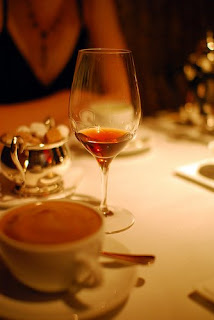
In your travels you might see wine labeled "Meritage" and wonder --not surprisingly -- just what it is.
Meritage wines are California's answer to Bordeaux blends and to labeling restrictions that require at least 75% of a wine's juice come from a single grape (like Cabernet Sauvignon) in order that it be labeled Cabernet.
In Bordeaux, however, where fabled and sought-after reds and whites are produced, the blend of juice in a wine is often much more even--say 60% Cabernet and 40% Merlot. These wines are simply labeled "Bordeaux" after the place they were made.
Here is the US, where bottles made with a single variety are the norm, consumers have sometimes looked askance at blended wines and assumed they represented lesser quality. Not so, says the
Meritage Association, an organization founded in the US in 1988 to promote and produce blanded wines in the Bordeaux tradition. Blended wines can provide wine lovers with greater complexity, age-worthiness, and also a more affordable price--so what's not to like?
I recently tried two
very good QPR Meritage blends that I think warrant a second look if you are looking for an affordable red blend that will go well with winter foods such as soups, stews, casseroles, and roasts.
The 2006 Hayman & Hill Meritage Reserve, for example, is made from a blend of 43% Cabernet Sauvignon, 25% Merlot, 15% Malbec, 11% Petit Verdot, and 6% Cabernet Franc fruit from Monterey County. (sample;
available from $12-$17) Upon first opening, I smelled the traditional Bordeaux aromas of cassis, plum and spice. Flavors of plum turned more towards cherry as you sipped, and there were some oaky notes and good acidity. Over time, with air, the flavors became much richer and plummier and developed milk chocolate notes. I would expect this wine to improve over the next 12-18 months, although it is delicious now.
The 2006 Robert Mondavi Private Selection Meritage, on the other hand, is made with 72% Cabernet Sauvignon, 10% Merlot, 10% Petite Verdot, 7% Malbec, and 1% Cabernet Franc fruit from California. (sample;
available for $8-$11). This is a very new release and was a bit hot upon first opening, but at 13.5% alc/vol I think this is a sign of youth. Once again I smelled the typical Bordeaux aromas of cassis and plum, and the flavors are dominated by rich plum. There are vanilla and mocha notes in the aftertaste which added complexity and contributed to the enjoyment of this easy-drinking red.
If you haven't tried Meritage and like Cabernet Sauvignon or Merlot, you should give one of these blended reds a try.
 Tomorrow--Saturday, February 28--is the 10th annual Open That Bottle Night.
Tomorrow--Saturday, February 28--is the 10th annual Open That Bottle Night.





















